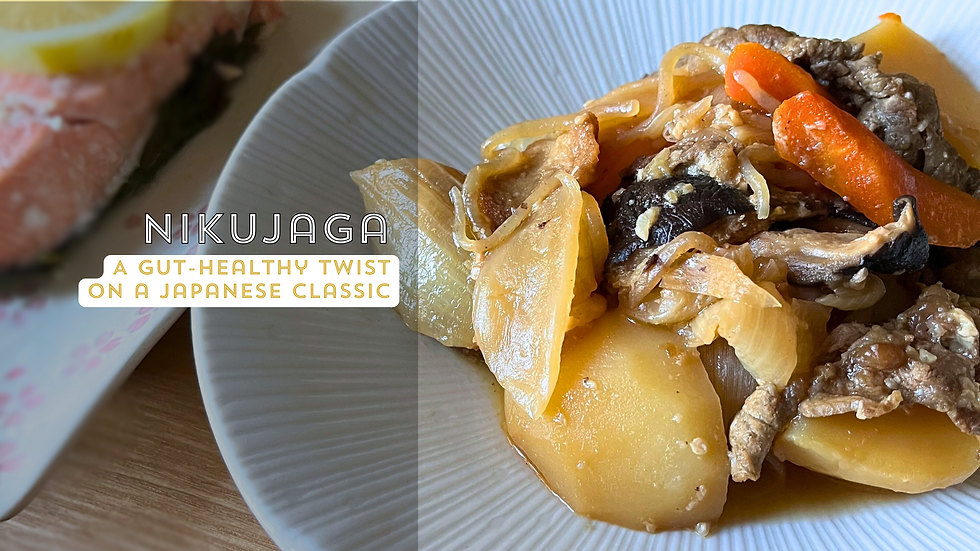Nikujaga with Fermented Seasonings
- Hitomi
- Sep 8
- 3 min read
Updated: Sep 8
A Gut-Friendly Twist on Japan’s Favorite Comfort Food

CONTENTS
ABOUT THIS RECIPE |
Nikujaga, or Japanese meat-and-potato stew, is one of Japan’s most beloved home-style dishes. Traditionally made with sugar and broth, this recipe reimagines it using only fermented seasonings—soy sauce koji, amazake, and sake. With the natural umami from vegetables and dried shiitake, you get a dish that is both comforting and nourishing for your gut.
RECIPE OVERVIEW |
Prep Time: 20 minutes (+6–12 hours shiitake soaking)
Cook Time: 45 minutes
Total Time: ~1 hour (+soaking/cooling time)
Serving Size: 4 servings
Cuisine: Japanese
Equipment Needed: Pan with lid, knife, cutting board, bowl
Difficulty Level: Intermediate
Suitable For: Dairy-free, refined sugar-free (vegan option available if meat omitted)
NUTRITION & GUT HEALTH BENEFITS |
Soy Sauce Koji: rich in enzymes, boosts digestion, enhances umami.
Ama-Koji/Amazake: probiotic-rich, a natural sweetener that supports gut microbiota.
Dried Shiitake: concentrated umami + vitamin D for immune support.
Sendai Fu: plant protein source, supports satiety and gut health.
Shirataki: low-calorie, fiber-packed, supports weight management.
Vegetables (onion, potato, carrot): provide prebiotics, vitamins, and minerals.
INGREDIENTS |
2 Onions
4 Potatoes
1 Carrot
5 Dried Shiitake Mushrooms (Rehydrated)
2 Rolls Sendai Fu (or regular fu, optional)
1 Pack Shirataki Noodles
300g Thin-sliced Ribeye (Sukiyaki Cut)
2 Tbsp Sesame Oil
½ cup Soy Sauce Koji
½ cup Ama-Koji (Sweet Koji) or Aamazake
½ cup Sake
INSTRUCTIONS |

1. (Do this half a day in advance) Soak dried shiitake mushrooms in cold water for about 12 hours to rehydrate slowly.

2. Cut the Sendai Fu (or regular wheat gluten) into about 1-inch pieces and soak them in plenty of water for about 15 minutes.

3. Rinse shirataki and cut into 4 sections.

4. Slice the onions into thick wedges. Peel and cut the potatoes into bite-sized chunks. Cut the carrot into bite-sized pieces (no need to peel).

5. Mix soy sauce koji and ama-koji together.

6. Remove the shiitake from the soaking water, trim off the tough stems, and cut the caps in half. Tip: The soaking liquid is full of umami, so don’t throw it away—use it for other Japanese dishes like soups or simmered vegetables.

7. In a cold pan, add sesame oil and beef, sauté until browned, then remove.

8. In the same pan, cook onions, potatoes, and carrots until lightly golden.

9. Deglaze with sake, cook for 3 min to evaporate alcohol.

10. Add shiitake, shirataki, beef, then pour in soy sauce koji + amazake. Top with fu.

11. Cover and simmer for 15 minutes. Then gently mix the contents, being careful not to break the potatoes or fu.

12. Cover again and simmer for another 15 minutes, until the potatoes are fully tender and flavors have absorbed. (You can eat it immediately, but the flavor deepens best after cooling and reheating.)
For the best result, let it rest at room temperature for 2–3 hours, then reheat before serving hot.
RECIPE NOTES |
If dried shiitake is unavailable, fresh shiitake works too.
Keep shiitake soaking water—it makes excellent dashi for other dishes (store up to 1 week refrigerated).
Adjust ama-koji/amazake sweetness to your preference.
Skip the beef for a vegan-friendly version.
SERVING SUGGESTIONS |
Serve hot with a side of multigrain rice and miso soup for a complete Japanese gut-friendly meal. Tastes even better the next day as flavors deepen.
FINAL THOUGHTS |
This Nikujaga with fermented seasonings is proof that comfort food can be both delicious and nourishing. By replacing sugar and broth with koji-based seasonings, you get a naturally sweet, probiotic-rich dish that supports gut health while delivering all the cozy flavors of traditional Japanese cooking.






Comments